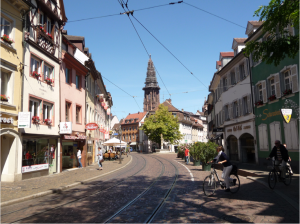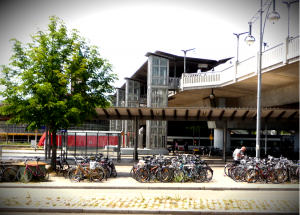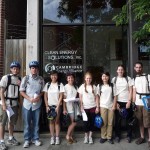Cars are prominent in Freiburg, but there is a different relationship between people, bicycles, transit and cars compared to home. Cars defer to pedestrians, bicyclists, and transit as they negotiate the city streets. Bicyclists and pedestrians move around each other fluidly. There is also a higher level of convenience in using non-automobile travel modes.
Freiburg has made the Altstadt – the old core of the city – a car-free zone. Only residents who live within the zone and service vehicles can drive in. Pedestrians, cyclists, and the tram are freer to move. Fraziska Breyer of the City government told us that when the car-free zone was proposed, businesses were very concerned that shoppers would shun the center. But the decision has instead made the old city a more attractive area for shoppers and visitors. The streets are bustling with people and cyclists are everywhere. To some degree there are too many cyclists in the old city. On the main street of Kaiser Joseph Strasse, the city had to prohibit bicycle parking near the area where the tram lines intersect because they were blocking walkers.
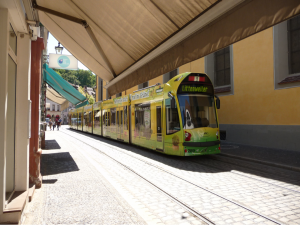
The tram (street car) system is excellent The trams do not for the most part run on separate rights-of-way. They run on rails in the street along with the cars and cyclists. Throughout the city, trams have traffic signal priority; the lights change as the trams approach to allow the tram to move through intersections. And the system makes it very easy to use the tram. Tickets can be bought at electronic vending machines and there are multiple choices – single rides, all day passes, group passes, etc. When you board the tram, there are no conductors or turnstiles to go through. Riders are expected to punch the tickets themselves to mark the time their use started. Conductors do spot checks and scofflaws can be fined. When waiting for the tram, there are electronic information boards that give riders real time information on when the next tram will arrive. There is also an extensive bus system, although I didn’t have the opportunity to ride a bus. To top it all off, the public transportation system is 100% powered by renewable energy – 80% hydro and 20% solar, wind, and other renewables.
There is an extensive network of bicycle lanes, paths, and roads. We were told there are 410 kilometers of these facilities. In some areas whole street segments are marked to give bicycles priorities. Cars can be on these bicycle roads, but they have to drive at similar speeds to cyclists and defer to them.
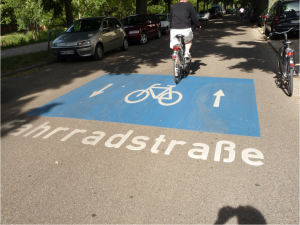 Traffic rules are enforced on cars and cyclists. A 30 kilometer per hour speed limit applies in the city center. It’s enforced by radar and photo. Cyclists are expected to follow traffic rules too. Frau Breyer said she once turned right at an intersection without stopping at a sign and was caught by the police. She received a ticket.
Traffic rules are enforced on cars and cyclists. A 30 kilometer per hour speed limit applies in the city center. It’s enforced by radar and photo. Cyclists are expected to follow traffic rules too. Frau Breyer said she once turned right at an intersection without stopping at a sign and was caught by the police. She received a ticket.
Freiburg has a non-profit car sharing association. It sounded like it has had a similar effect to Zipcar in Cambridge, providing an alternative for people who don’t want to own a car and eliminating the need for owning a second car.
Freiburg seems to take all modes of transit and weave them into a seamless system. Our study group took a bicycle tour of the city’s sustainability highlights. We rented bicycles at a shop housed in a building that also provided bicycle parking for a fee on two levels and car sharing below. The building was located at the main train station, which was intersected by the tram system. Buses and taxi stations were also located there. The whole system was reliable, flexible, safe, and enjoyable.
The transportation mode shares reported by the city in 1999 – the City said the data is being updated – is 23% pedestrian, 27% bicycles, 18% transit, 6% ride sharing, and 26% single occupancy driving. I’m not sure if that is all trips (I think that is so) or just commuting.
I wasn’t able to learn all the factors that enable Freiburg to have such a wonderful transportation system. I’m sure there are reasons why it is easier to have such a great system in Freiburg, but it makes you want to replicate it at home.
Next: Freiburg’s eco-villages – Reiselfeld and Vauban.

